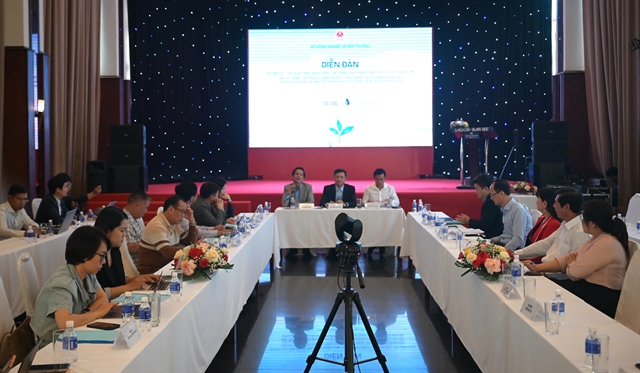 Environment
Environment

The lives of residents in Nam Trực District in the northern province of Nam Định have improved over the years thanks to aluminum recycling for handicrafts. But it now seems this was a double-edged sword.
 |
| The lives of residents in Nam Trực District in the northern province of Nam Định have improved over the years thanks to aluminum recycling for handicrafts. But it now seems this was a double-edged sword. — Photo danviet.vn |
NAM ĐỊNH — The lives of residents in Nam Trực District in the northern province of Nam Định have improved over the years thanks to aluminum recycling for handicrafts. But it now seems this was a double-edged sword.
According to test results by the Natural Resources and Environment Ministry, the water of Nam Ninh Hải River running through the district, is seriously polluted with toxic levels far higher than allowed. Chemicals discharged by aluminum recycling workshops are also harming aquatic creatures and ecosystem, the survey found.
The province’s environmental and health authorities have urged all recycling workers to have their health checked to ensure they are not suffering aluminum poisoning.
Bình Yên Village located near the river, which had been succeeded in collecting and recycling alluminum for many years, was recognised as one of the major sources of pollution and also bearing the most impact of the pollution, local authority reported.
More than 300 households in the village have been recycling aluminum for nearly 30 years with a capacity of over 1,500 tonnes of waste per month.
Every day, more than 1,000 labourers collect beer cans and other canned drinks to produce basins, trays and pots. Most of the recycling, including the melting process, is performed using simple methods at home or in fields.
At one time, villagers’ livelihoods depended on their fields. Only four families recycled aluminum waste collected from Vân Chàng Village and some places in neighbouring Bắc Ninh Province.
But seeing the high profits, other villagers joined in.
Their lives have improved significantly, even as the noise, machinery and chemicals were polluting the air and water around them.
River water has turned a yellowish color caused by chemicals. Dozens of tonnes of solid hazardous waste are released every day.
Many hectares of agricultural land have been abandoned due to pollution. Irrigation canals are also affected.
Nguyễn Thị Liên, a local resident, said the village river has been polluted for many years due to untreated waste water from recycling households.
In 2008, an international Swiss organisation along with local authorities implemented a project to help three local households limit the pollution from waste water and dust during the recycling process.
The project also included building more than 90 biogas reservoirs, over 150 chimneys and hundreds of big plastic barrels for washing products, with a total investment of VNĐ465 million (over US$20,000).
However, after the project ended, local people could not afford further investment in these facilities and the biogas reservoirs and chimneys have not met the needs of the increased production scale.
Another project to deal with waste gas and water and solid waste, funded by the Pollution Control Department under the Việt Nam Environment Administration, is still in the pilot stage due to lack of funds.
A recent survey by the Ministry of Natural Resources and Environment of 52 handicraft villages nationwide has found that 46 per cent are severely polluting the village air, water and land, as well as causing noise pollution.
The survey also showed that people living in or near craft villages that are discarding metal or solid wastes are at higher risks of contracting mental disease, respiration problems and even cancer. — VNS




